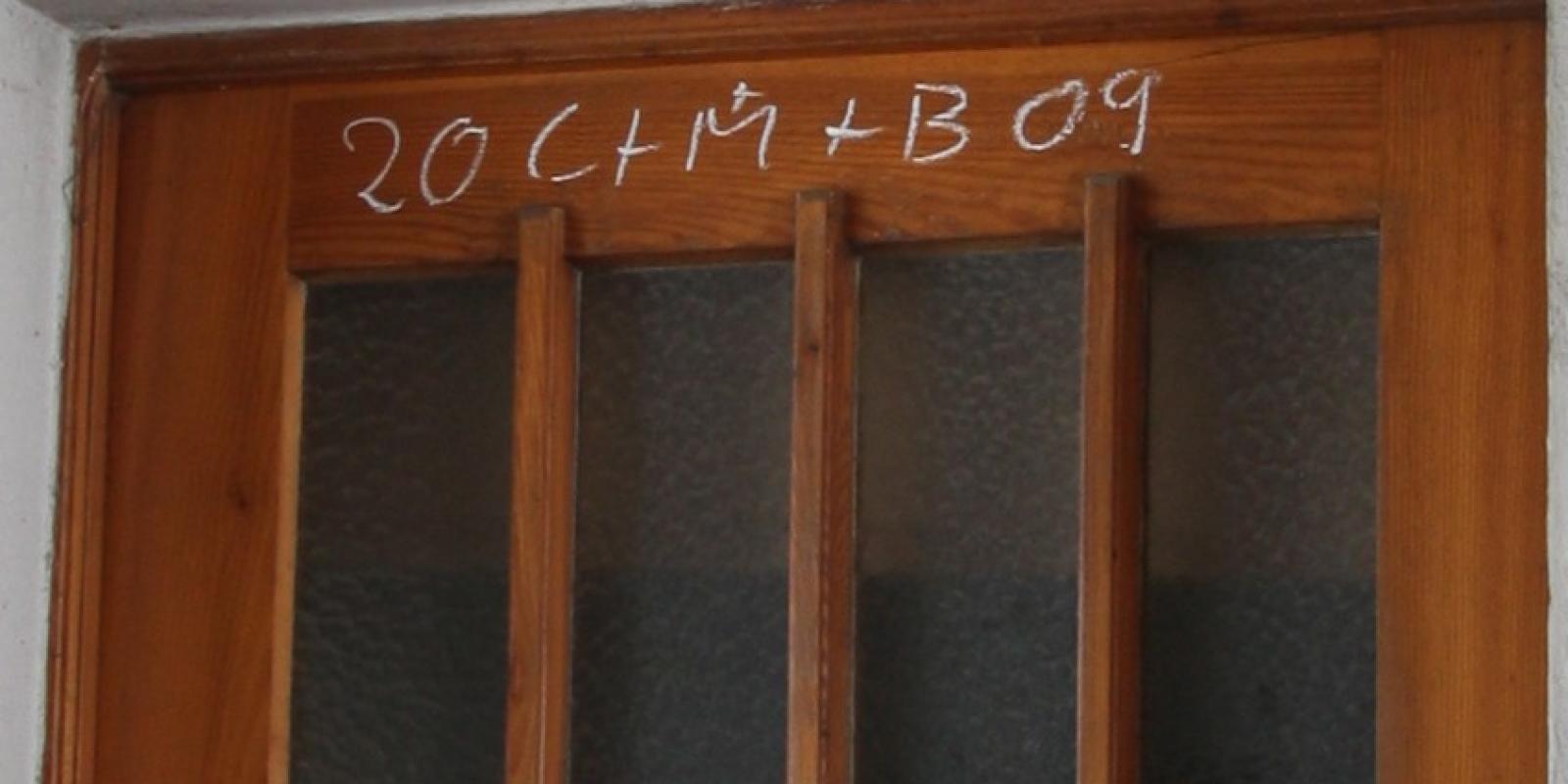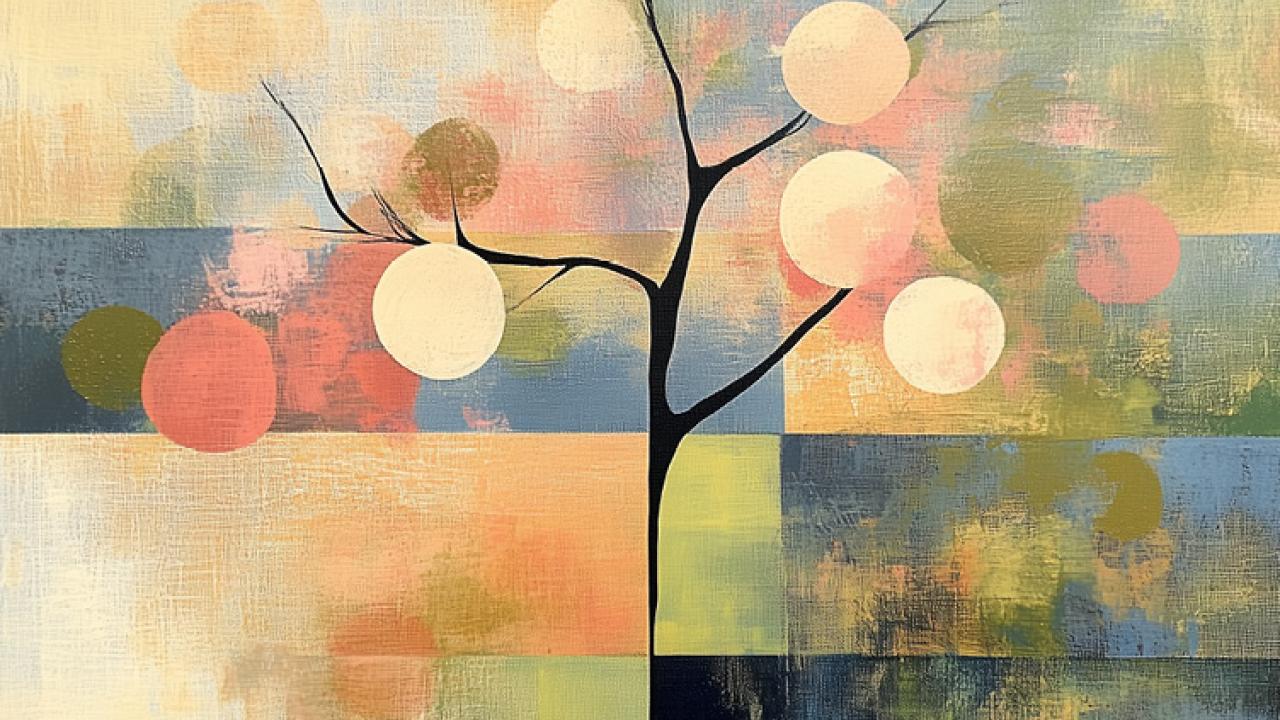I was “today years old” when I learned about the chalking of the doors, and I’m eager to add it to my collection of practices that help connect communal worship with home life and worship. Such practices deepen faith and help us live with a greater awareness of Christ’s presence and the call to be a light in this world.
To help those who, like me, may be unfamiliar with the chalking of doors, an explanation is provided. I suggest introducing the concept in a church newsletter or social media post, then using the Epiphany service to further draw the connection between Epiphany and this practice. Also included below is a liturgy that can be downloaded and handed out for congregants to take home and use.
Chalking of the Doors
The practice of the “chalking of the doors” seems to have begun in Eastern Europe or areas of Slavic origin toward the end of the Middle Ages. In Exodus we read about how the Israelites painted blood on their doorframes to protect them from the angel of death, who killed the firstborn sons of all the Egyptians. In Deuteronomy, the Israelites are told to remember the works of the Lord, to teach them to their children, to talk about them, and to “write them on the doorframes of your houses and on your gates” (Deuteronomy 6:9; 11:20). There is a two-fold purpose in marking one’s doorframe during Epiphany: to protect and bless those within the home by inviting Christ into it, and to bear testimony to the household’s trust in God. These two themes of blessing and bearing witness fit well with the message of Epiphany. The Magi responded to a sign, a visible symbol, with faith and action. They came, bearing gifts, to worship the Christ-child, and they left blessed. Though Scripture doesn’t say if they told others about their experience, it’s hard to imagine them returning home without testifying to all that they had witnessed.
For us today, the act of chalking the door can be both a reminder of Christ’s presence with us as well as a countercultural testimony to all who pass by or enter our homes that Christ is Lord of our lives. In fact, in some places in Eastern Europe when the Soviet government was trying to stamp out Christianity, the act of chalking the doors became a protest as well as a faith statement.
Chalking the doors is most often done on the feast of Epiphany, January 6 (the twelfth day of Christmas), but it would be equally meaningful any time in the
Epiphany season, especially toward the beginning of the year. Chalk is used because it reminds us of our fragility—that we are dust. It is also simple, accessible, and not permanent, for what is written is not magical, but rather a tool for writing God’s truths on our hearts and searing them in our mind. Of course, painting a wooden sign with the symbol or writing it on a paper would also be fine.
In the year 2022, the sign written on the doorframe is 20+C+M+B+22. The outer numbers are the year. The + symbols represent the cross and could be written as such. The C, M, and B carry two meanings: It could refer to the names traditionally given to the Magi—Caspar, Melchior, and Balthasar—but there were likely many more than three magi who visited the Holy Family. Better, it reflects the Latin phrase Christus mansionem benedicat—“May Christ bless this dwelling.”
When chalking the door, you may choose to spend time wondering about what it would be like if Jesus were physically present in the house. How would Christ’s presence affect how we interact with each other in our words, work, or play? How would Christ’s presence affect how we respond to both invited and unexpected guests on our doorsteps? Write the symbols on the doorframe to remind each other of Christ’s spiritual presence, and offer your own prayer asking Christ to bless the home (or office, or classroom, or hospital room) and all who enter it.
For a stronger connection to communal worship, you could encourage your congregants to use the liturgy that follows the Epiphany service below.
An Epiphany Service
Prelude
Begin this service with notes of joy.
Call to Worship
[This call to worship should not be read. While there is a script here, much of it could be ad-libbed.]
Voice 1 [with great enthusiasm]:
Everyone,
Christ has been born, the light has come.
So join me in celebration!
Voice 2 [with consternation]:
Celebrate? Celebrate?
Have you not heard the news?
Where have you been living?
[Add the troubling news of the day.]
Evil and death are everywhere.
There is no hope.
Voice 3 [with a gently correcting tone]:
Don’t you see it,
that light that is growing?
The good that is happening right around you?
Christ has been born. The Spirit is all around us!
Voice 1:
Open your eyes and look around you!
People are gathered here to worship.
The Spirit is at work here.
The Spirit is at work around the world.
Voice 3:
You should see the gifts that are
flowing out of God’s people,
a testimony that indeed the light has come!
There is hope!
Voice 1:
One day there will be no more evil,
no more grief, no more fear.
We have hope!
Voice 3:
So come, join all God’s people in proclaiming
the praise of the Lord!
All Voices:
“Arise, shine, for your light has come,
and the glory of the LORD rises upon you.”
—Rev. Joyce Borger, based on Isaiah 60:1–6 © 2021 ReformedWorship.org, CC BY-NC-SA 4.0.
Opening Medley
“Arise, Shine, for Your Light Is Come” Glass
“Glory Hallelujah” Schoolmeester (English/Spanish)
or
“Jesus Shall Reign / Psalm 72” Watts
God’s Greeting
Thus says God, the LORD,
who created the heavens and stretched them out,
who spread out the earth and what comes from it,
who gives breath to the people on it
and spirit to those who walk in it:
“I am the LORD; I have called you in righteousness;
I will take you by the hand and keep you;
I will give you as a covenant for the people,
a light for the nations,
to open the eyes that are blind,
to bring out the prisoners from the dungeon,
from the prison those who sit in darkness.
I am the LORD; that is my name;
my glory I give to no other,
nor my praise to carved idols.
—Isaiah 42:5–8 ESV
Song of Praise
“O Come, All Ye Faithful” Wade
or
“O Come Let Us Adore Him” Maverick City Music
Prayer of Confession
We’ve come today to give praise to our God, to continue to celebrate the gift of God’s Son, the light of the world. We want to give God all the praise and glory, but do we? God may be worthy of it all, but do we give God our all? God has blessed us, but what have we given in return?
Sung Refrain: “Come, Light, Light of God” The Sisters of the Community of Grandchamp, Switzerland
Eternal Light,
shine into our hearts;
Eternal Goodness,
deliver us from evil;
Eternal Power,
be our support;
Eternal Wisdom,
scatter the darkness of our ignorance;
Eternal Compassion,
have mercy upon us;
that with all our heart and mind
and soul and strength
we may seek your face
and be brought by your infinite mercy
to your holy presence;
through Jesus Christ our Light. Amen.
—Alcuin of Tours (8th century)., P.D. alt.
Sung Refrain: “Come, Light, Light of God” The Sisters of the Community of Grandchamp, Switzerland
Words of Assurance
1 John 1:5–7
Sung Refrain: “Come, Light, Light of God” The Sisters of the Community of Grandchamp, Switzerland
Prayer for Illumination
God of light and life,
open our eyes as well as our ears,
so that we may not only hear your Word preached today
but then see your Word lived out in our lives and in your world,
through Christ, our Lord, the light of the world.
Amen.
—The Worship Sourcebook F.3.1.2
Scripture Reading
Matthew 2:1–12
Sermon: Signs, Gifts, and Testimony
Sermon Response
[Invite people who would like to chalk their doors to pick up chalk and a copy of the liturgy found below in the resource section, or provide other directions that fit your context.]
Sung Response
Prayers of the People
Offering
Traditionally on Epiphany an offering is taken for benevolence or missions.
Sending and Blessing
As we leave this service of worship,
let us go as the Magi left the infant Jesus,
rejoicing on our way that we have seen the living Lord,
ready to return to our daily life and work,
spreading the good news of Jesus, the light of the world.
Receive now these words of promise and blessing
from our Lord Jesus Christ:
Remember, “I am with you always, to the end of the age.”
“Peace I leave with you; my peace I give to you.
Do not let your hearts be troubled.
Do not be afraid.
I am the light of the world.
Whoever follows me will never walk in darkness
but will have the light of life.”
Amen.
—from Matthew 28:20; John 14:27; The Worship Sourcebook F.9.4 alt.
Closing Song
Choose one of the following or another of your choice:
“Glory Hallelujah” Schoolmeesters (reprise)
“Hear Our Praises” Morgan, LUYH 302, SSS 414
“Jesus, the Light of the World” Wesley, Elderkin, LUYH 100
Pastoral Considerations
As you introduce the practice of chalking the doors to your congregation you may need to be pastorally sensitive to certain demographics in your congregation and offer some options. For those who live outside, in shelters, or in their cars, offer to pray a blessing prayer wherever they most often sleep at night. For those who live alone, ask an elder to offer to lead the liturgy or encourage those individuals to invite others over for the blessing or to include their small group. For those living in college dorms, hospitals, or other institutions, pray for Christ to be present in the room and get permission to write on the doorframe of the room. Again, there is nothing magical about writing the symbol or placing it on the door or doorframe, but it is a tool to represent the reality of Christ’s presence and an opportunity to worship and bear witness to Christ’s lordship.


